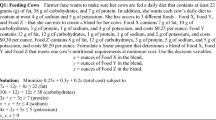Abstract
This study examines eighth grade students’ use of a representational metaphor (cups and tiles) for writing and solving equations in one unknown. Within this study, we focused on the obstacles and difficulties that students experienced when using this metaphor, with particular emphasis on the operations that can be meaningfully represented through this metaphor. We base our analysis within a framework of referential relationships of meanings (Kaput 1991; Kaput, Blanton, and Moreno, et al. 2008). Our data consist of videotaped classroom lessons, student interviews, and teacher interviews. Ongoing analyses of these data were conducted during the teaching sequence. A retrospective analysis, using constant comparison methodology, was then undertaken in order to generate a thematic analysis. Our results indicate that addition and (implied) multiplication operations only are the most meaningful with these representational models. Students also very naturally came up with a notation of their own in making sense of equations involving multiplication and addition. However, only one student was able to construct a “family of meanings” when negative quantities were involved. We conclude that quantitative unit coordination and conservation are necessary constructs for overcoming the cognitive dissonance (between the two representations—drawn pictures and the algebraic equation) experienced by students and teacher.









Similar content being viewed by others
Notes
All names are pseudonyms
References
College preparatory mathematics (Algebra 1), Second Edition (2002). T. Salle, J. Kysh, E. Kasimatis and B. Hoey (Program Directors). Sacramento, CPM Educational Program.
Hiebert, J., & Carpenter, T. P. (1992). Learning and teaching with understanding. In D. Grouws (Ed.), Handbook for research on mathematics teaching and learning (pp. 65–97). New York: MacMillan.
Kaput, J. (1991). Notations and representations as mediators of constructive processes. In E. von Glaserfeld (Ed.), Radical constructivism in mathematics education (pp. 53–74). The Netherlands: Kluwer Academic Publishers.
Kaput, J. J., Blanton, M. L., & Moreno, L. (2008). Algebra from a symbolization point of view. In J. J. Kaput, D. W. Carraher, & M. L. Blanton (Eds.), Algebra in the early grades (pp. 19–55). New York: LEA & NCTM.
Knuth, E. J., Stephens, A. C., McNeil, N. M., & Alibali, M. W. (2006). Does understanding the equal sign matter? Evidence from solving equations. Journal for Research in Mathematics Education, 37, 297–312.
Lesh, R., & Doerr, H. M. (2000). Symbolizing, communicating, and mathematizing: key components of models and modeling. In P. Cobb, E. Yackel, & K. McClain (Eds.), Symbolizing and communicating in mathematics classrooms: Perspectives on discourse, tools, and instructional design (pp. 361–384). Mahwah, NJ: Lawrence Erlbaum Associates, Publishers.
NCTM (2000). Principles and standards for school mathematics. Reston, VA.
Olive, J., & Vomvoridi, E. (2006). Making sense of instruction on fractions when a student lacks necessary fractional schemes: the case of Tim. Journal of Mathematical Behavior, 25, 18–45.
Olive, J., & Caglayan, G. (2008). Learners' difficulties with quantitative units in algebraic word problems and the teacher's interpretation of those difficulties. International Journal of Science and Mathematics Education, 6, 269–292.
Schwartz, J. L. (1988). Intensive quantity and referent transforming arithmetic operations. In J. Hiebert & M. Behr (Eds.), Number concepts and operations in the middle grades (pp. 41–52). Reston, VA: National Council of Teachers of Mathematics (NCTM) and LEA.
Sfard, A., & Linchevski, L. (1994). The gains and pitfalls of reification—the case of algebra. Educational Studies in Mathematics, 26, 191–228.
Thompson, P. W. (1993). Quantitative reasoning, complexity, and additive structures. Educational Studies in Mathematics, 25, 165–208.
Thompson, P. W. (1995). Notation, convention, and quantity in elementary mathematics. In J. Sowder & B. Schapelle (Eds.), Providing a foundation for teaching middle school mathematics (pp. 199–221). Albany, NY: SUNY Press.
Uttal, D. H., Scudder, K. V., & DeLoache, J. S. (1997). Manipulatives as symbols: a new perspective on the use of concrete objects to teach mathematics. Journal of Applied Developmental Psychology, 18, 37–54.
Vlassis, J. (2001). Solving equations with negatives or crossing the formalizing gap. In M. van den Heuvel-Panhuizen (Ed.), Proceeding of the 25th conference of the international group for the psychology of mathematics education (pp, Vol. 4, pp. 375–382). Utrecht: Freudenthal Institute.
Acknowledgments
The research reported in this article was supported by the National Science Foundation under Grant REC-0231879. The opinions expressed are our own and do not necessarily reflect the views of the National Science Foundation. We would like to thank Ms. Jennings and her students for allowing us to be part of their classroom.
Author information
Authors and Affiliations
Corresponding author
Rights and permissions
About this article
Cite this article
Caglayan, G., Olive, J. Eighth grade students’ representations of linear equations based on a cups and tiles model. Educ Stud Math 74, 143–162 (2010). https://doi.org/10.1007/s10649-010-9231-z
Published:
Issue Date:
DOI: https://doi.org/10.1007/s10649-010-9231-z




